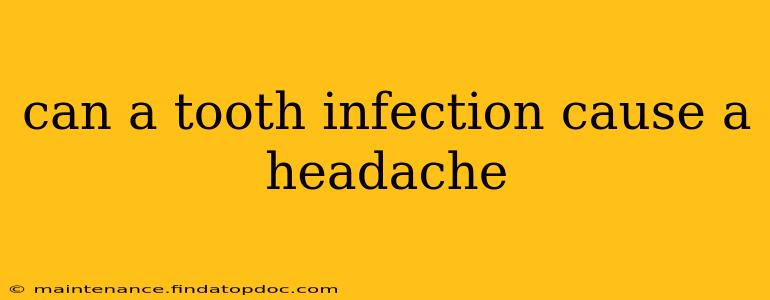Yes, a tooth infection, also known as an abscess, can absolutely cause a headache. The pain isn't just confined to your teeth and gums; it can radiate and manifest as a throbbing headache, often focused on one side of the head. This connection stems from the intricate network of nerves and blood vessels in your head and face. Let's delve deeper into why this happens and explore related questions.
How Does a Tooth Infection Lead to Headaches?
The pain from a tooth infection isn't just a localized sensation. The infection itself can cause inflammation and swelling, putting pressure on the nerves in your jaw and surrounding tissues. This pressure can travel along the trigeminal nerve, a major cranial nerve that branches out to supply sensation to the face, including the teeth, jaw, and even parts of the head. The intense inflammation and pressure can trigger pain signals that the brain interprets as a headache.
Furthermore, the infection itself can release toxins into your bloodstream. These toxins can cause systemic inflammation, which contributes to the overall discomfort and can manifest as a generalized headache, or even more intense pain localized near the infected tooth.
What Kind of Headache Does a Tooth Infection Cause?
The headache associated with a tooth infection is usually a unilateral headache, meaning it's typically felt on one side of the head, corresponding to the side of the infected tooth. The pain is often described as:
- Throbbing: A pulsating, rhythmic pain.
- Sharp: Intense, stabbing pain.
- Aching: A dull, persistent pain.
- Pressure-like: A feeling of tightness or pressure in the head.
The intensity of the headache can vary depending on the severity of the infection. It's crucial to note that this type of headache isn't usually a migraine, although it can share similar symptoms in terms of intensity and location.
Can a Toothache Cause a Headache in the Back of the Head?
While less common, a tooth infection can cause pain that radiates to the back of the head. This is less frequent because the primary nerve pathways involved in tooth pain primarily affect the front and sides of the head. However, the widespread inflammation caused by a severe infection can impact nerves throughout the head, potentially resulting in pain felt in the back of the head.
What Other Symptoms Accompany a Tooth Infection Headache?
A tooth infection headache rarely stands alone. Other symptoms usually accompany it, helping to pinpoint the source of the pain. These might include:
- Severe toothache: Intense pain in the affected tooth.
- Swelling in the gums or face: Noticeable inflammation around the infected tooth.
- Fever: An elevated body temperature due to the infection.
- Sensitivity to hot and cold: Increased pain when consuming hot or cold foods or drinks.
- Pus: A visible discharge of pus near the affected tooth.
- Difficulty opening your mouth (trismus): Pain and stiffness in the jaw muscles.
- Bad breath: A foul odor in the breath.
When Should I See a Dentist?
If you're experiencing a headache along with any of the symptoms listed above, it's crucial to see a dentist immediately. A tooth infection can lead to serious complications if left untreated. Delaying treatment can result in the spread of infection, damage to the tooth and surrounding tissues, and even more severe systemic effects. Early diagnosis and treatment are essential to prevent these complications. Don't wait for the pain to become unbearable; seek professional help as soon as you suspect a tooth infection.
